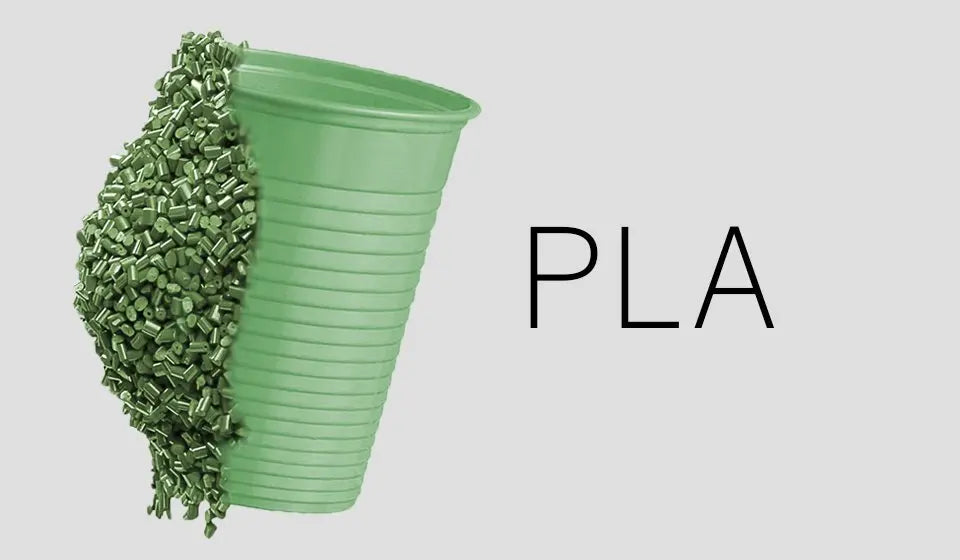PLA plastic is often hailed as an alternative to traditional plastics due to its biodegradability. However, is it truly a sustainable choice for the environment? Join us as we delve into this question in the article below.
1. PLA is still a plastic
PLA (Polylactic Acid) plastic, derived from natural sources like cassava starch or sugar beets, often leads to the misconception that it's entirely environmentally friendly. However, the truth is, PLA is still a type of plastic.

Source: Internet
2. Difficult to recycle
PLA poses recycling challenges due to its inability to be easily processed alongside common plastics like PET or HDPE. Unlike traditional plastics categorized by code for streamlined recycling, PLA often requires separate handling.
Additionally, recycling PLA demands specific temperature and climate conditions, which many facilities lack. Consequently, establishing an efficient recycling infrastructure for PLA becomes challenging, leading to increased costs and inefficiencies in the recycling process.

Source: Internet
3. The complex production process consumes resources
The production process of PLA plastic is not simple and resource-efficient. Although the main source of PLA is renewable plants, the process of converting natural materials into PLA plastic still requires a large amount of energy.
- First, to produce PLA, raw materials such as cassava starch and sugar beets must be harvested and processed. This process involves the use of machinery and chemicals and also requires the expenditure of energy to transport raw materials from the production site to the PLA manufacturing plant.
- Next, the chemical process to convert raw materials into PLA plastic also consumes a lot of energy and uses catalysts and solvents. Even though PLA is considered a bioplastic, its production still hurts the environment.

Source: Internet
In addition, the PLA production process also creates a large amount of waste and byproducts, affecting the environment around the manufacturing plant.
>> Read More:
- PLA Plastic: Everything You Need to Know
- What Is PP Plastic (Polypropylene)? Is It Toxic?
- PE (Polyethylene) Plastic: An Overview Of Its Properties, Classification, And Common Applications In Daily Life
- Tackling the Plastic Waste Crisis: Understanding, Realities, and Solutions
4. PLA plastic can only decompose under industrial processing conditions
One of the major weaknesses of PLA plastic is that it only decomposes under industrial processing conditions, not in the natural environment or under normal conditions.
PLA requires a specific combination of temperature and microorganisms to decompose. In the natural environment, the temperatures and microorganisms needed to decompose PLA are often insufficient, resulting in the plastic remaining for a long time.

Source: Internet
Even under normal home conditions, temperature and microorganisms are not enough to effectively decompose PLA. If PLA products are not collected and processed properly, they can still cause environmental pollution and create plastic waste.
5. The product decomposes into microplastics that are harmful to the environment and organisms
Although PLA plastic is touted as an environmentally friendly option, PLA decomposition products can also be harmful to the environment and organisms in some cases.
When PLA plastic decomposes under industrial processing conditions, it often breaks down into small particles, called microplastics. These microplastics can continue to exist in the natural environment for long periods and can be absorbed into biological systems through the food chain. This can cause health problems for marine life and animals at every level of the food chain, from small microorganisms to large animals.

Source: Internet
Furthermore, in freshwater and soil environments, decomposition products from PLA plastic can create toxic substances when decomposed, affecting the growth of plants and animals living underground.
Should or should not use PLA plastic?
PLA plastic, although considered a greener alternative to traditional plastic, still has certain environmental limitations. Therefore, the use of PLA plastic should be carefully considered and should only be used when necessary.
Instead of PLA plastic, priority should be given to using products made from natural materials that are completely degradable.
Completely biodegradable natural products - The most sustainable solution
Products from natural materials that are completely biodegradable are considered the most sustainable solution to reduce the impact of plastic waste on the environment. Instead of using PLA or other bioplastics, products are made from natural materials that are naturally and completely degradable.
The biggest benefit of using products from completely biodegradable natural materials is that it does not cause sustainable plastic waste. When these products are disposed of in the environment, they will naturally decompose within a short period, returning to organic substances that do not pollute the environment.
EQUO products are made from 100% natural materials, do not contain plastic, and can biodegrade within 3-6 months:
- Plant-based straw set that decomposes itself: Made from coffee, bagasse, coconut, grass, and rice, safe for health, and completely compostable in the natural environment.
- Food containers: Made from sugarcane bagasse, which is a sustainable natural resource that is renewable and decomposes quickly. The outstanding characteristics of bagasse fiber lie in its durability, flexibility in packaging, and breathable and waterproof qualities.
- Utensils: Made from sugarcane fibers and coffee grounds, these spoons, forks, and knives are elegant, durable, and can completely decompose in environment. This is a great choice for eco-friendly and durable tableware sets.
- Paper cups and lids with water-based coating: Using a water-based coating, instead of plastic (PP, PE, or PLA), helps the production process emit less carbon dioxide (CO2) and minimizes negative impacts on the environment during decomposition compared to regular paper cups. These cups completely decompose in the natural environment within 18 weeks and come in various sizes, making them suitable for a wide range of uses.
Let's join hands with EQUO to use environmentally friendly products. For more information about EQUO product lines, please visit the following link:
>> https://shopequo.com/collections

Although PLA plastic has certain advantages, there are still many limitations in terms of sustainability. To aim for a clean and green environment, we need to consider carefully before using PLA and prioritize friendlier alternatives such as EQUO's completely biodegradable natural products. With the mission of protecting the environment and leading a green lifestyle, EQUO is committed to providing consumers with quality, safe, and environmentally friendly products.


